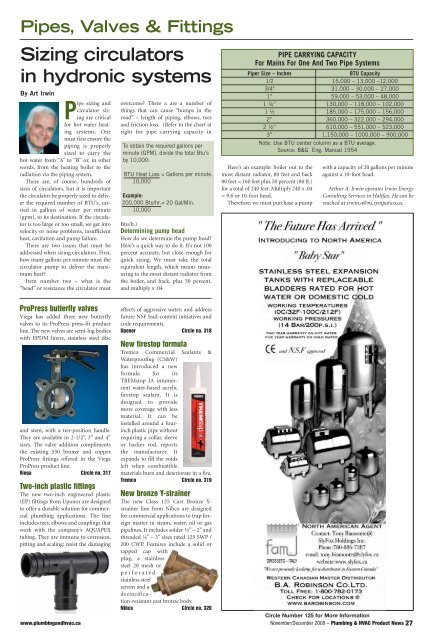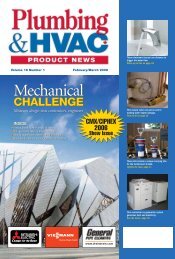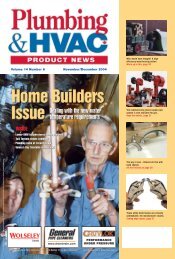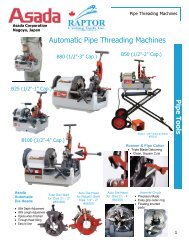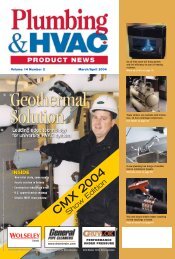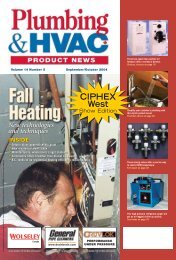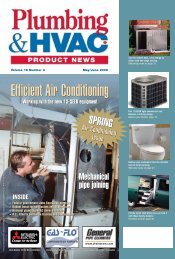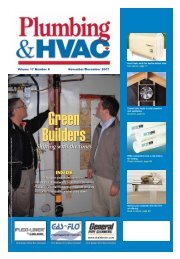December 2008 - Plumbing & HVAC
December 2008 - Plumbing & HVAC
December 2008 - Plumbing & HVAC
You also want an ePaper? Increase the reach of your titles
YUMPU automatically turns print PDFs into web optimized ePapers that Google loves.
Pipes, Valves & Fittings<br />
Sizing circulators<br />
in hydronic systems<br />
By Art Irwin<br />
Pipe sizing and<br />
circulator sizing<br />
are critical<br />
for hot water heating<br />
systems. One<br />
must first ensure the<br />
piping is properly<br />
sized to carry the<br />
hot water from “A” to “B” or, in other<br />
words, from the heating boiler to the<br />
radiation via the piping system.<br />
There are, of course, hundreds of<br />
sizes of circulators, but it is important<br />
the circulator be properly sized to deliver<br />
the required number of BTU’s, carried<br />
in gallons of water per minute<br />
(gpm), to its destination. If the circulator<br />
is too large or too small, we get into<br />
velocity or noise problems, insufficient<br />
heat, cavitation and pump failure.<br />
There are two issues that must be<br />
addressed when sizing circulators. First,<br />
how many gallons per minute must the<br />
circulator pump to deliver the maximum<br />
heat?<br />
Item number two – what is the<br />
“head” or resistance the circulator must<br />
overcome? There a are a number of<br />
things that can cause “bumps in the<br />
road” – length of piping, elbows, tees<br />
and friction loss. (Refer to the chart at<br />
right for pipe carrying capacity in<br />
To obtain the required gallons per<br />
minute (GPM), divide the total Btu’s<br />
by 10,000:<br />
BTU Heat Loss = Gallons per minute.<br />
10,000<br />
Example:<br />
200,000 Btu/hr.= 20 Gal/Min.<br />
10,000<br />
Btu/h.)<br />
Determining pump head<br />
How do we determine the pump head?<br />
Here’s a quick way to do it. It’s not 100<br />
percent accurate, but close enough for<br />
quick sizing. We must take the total<br />
equivalent length, which means measuring<br />
to the most distant radiator from<br />
the boiler, and back, plus 50 percent,<br />
and multiply x .04<br />
PIPE CARRYING CAPACITY<br />
For Mains For One And Two Pipe Systems<br />
Piper Size – Inches<br />
BTU Capacity<br />
1/2 15,000 – 13,000 –12,000<br />
3/4" 31,000 – 30,000 – 27,000<br />
1” 59,000 – 53,000 – 48,000<br />
1 ¼” 130,000 – 118,000 – 102,000<br />
1 ½ 185,000 – 175,000 – 156,000<br />
2” 360,000 – 322,000 – 294,000<br />
2 ½” 610,000 – 551,000 – 523,000<br />
3” 1,150,000 – 1000,000 – 900,000<br />
Note: Use BTU center column as a BTU average.<br />
Source: B&G Eng. Manual 1954<br />
Here’s an example: boiler out to the<br />
most distant radiator, 80 feet and back<br />
80 feet = 160 feet plus 50 percent (80 ft.)<br />
for a total of 240 feet. Multiply 240 x .04<br />
= 9.6 or 10-foot head.<br />
Therefore, we must purchase a pump<br />
with a capacity of 20 gallons per minute<br />
against a 10-foot head.<br />
Arthur A. Irwin operates Irwin Energy<br />
Consulting Services in Halifax. He can be<br />
reached at irwin.a@ns.sympatico.ca.<br />
ProPress butterfly valves<br />
Viega has added three new butterfly<br />
valves to its ProPress press-fit product<br />
line. The new valves are semi-lug bodies<br />
with EPDM liners, stainless steel disc<br />
and stem, with a ten-position handle.<br />
They are available in 2-1/2”, 3” and 4”<br />
sizes. The valve addition compliments<br />
the existing 550 bronze and copper<br />
ProPress fittings offered in the Viega<br />
ProPress product line.<br />
Viega Circle no. 317<br />
Two-inch plastic fittings<br />
The new two-inch engineered plastic<br />
(EP) fittings from Uponor are designed<br />
to offer a durable solution for commercial<br />
plumbing applications. The line<br />
includes tees, elbows and couplings that<br />
work with the company’s AQUAPEX<br />
tubing. They are immune to corrosion,<br />
pitting and scaling; resist the damaging<br />
effects of aggressive water; and address<br />
future NSF lead-content initiatives and<br />
code requirements.<br />
Uponor Circle no. 318<br />
New firestop formula<br />
Tremco Commercial Sealants &<br />
Waterproofing (CS&W)<br />
has introduced a new<br />
formula for its<br />
TREMstop IA intumescent<br />
water-based acrylic<br />
firestop sealant. It is<br />
designed to provide<br />
more coverage with less<br />
material. It can be<br />
installed around a fourinch<br />
plastic pipe without<br />
requiring a collar, sleeve<br />
or backer rod, reports<br />
the manufacturer. It<br />
expands to fill the voids<br />
left when combustible<br />
materials burn and deteriorate in a fire.<br />
Tremco Circle no. 319<br />
New bronze Y-strainer<br />
The new Class 125 Cast Bronze Y-<br />
strainer line from Nibco are designed<br />
for commercial applications to trap foreign<br />
matter in steam, water, oil or gas<br />
pipelines. It includes solder ½” – 2” and<br />
threaded ¼” – 3” sizes rated 125 SWP /<br />
200 CWP. Features in clude a solid or<br />
tapped cap with<br />
plug, a stainless<br />
steel 20 mesh or<br />
perforated<br />
stainless steel<br />
screen and a<br />
dezincification-resistant<br />
cast bronze body.<br />
Nibco Circle no. 320<br />
Circle Number 125 for More Information<br />
www.plumbingandhvac.ca November/<strong>December</strong> <strong>2008</strong> – <strong>Plumbing</strong> & <strong>HVAC</strong> Product News 27


